
 |
| Online papers / Journal Articles
This complex process is exemplified in the the case of monuments to distant wars. Here, as Inglis suggests, the technological difference is significant: 'where the French speak of monuments aux morts, the English say 'war memorials'.' Memorial leaves open the form of commemoration that may, or may not, be monumental(7). In largely Protestant, voluntarist countries such as Britain, hospitals, libraries and other utilitarian memorials had long been considered to be structures appropriate for commemoration. Victorian and Edwardian Britain is strewn with the evidence of philanthropic and state benefaction. After the Great War, British memorials varied in object from avenues of trees to utilitarian schemes such as community halls, recreation grounds, convalescent homes (8) and, in one case, a waterpipe to a local school(9). However, in 1919 the need to find a tolerable meaning to the Great war more often demanded monumental form. Reverential structures such as cenotaphs had several functions. Initially they acted as a focus for personal, public and civic displays of grief. Their iconic form helped to reassure noncombatants and relatives that the dead died for a greater cause, on that was linked to abstract values of nationhood, camaraderie or Christian citizenship. Through the annual ritual of Armistice services they gradually became the focus of communal and individual remembrance opening up a discourse of healing, regret and reflection. In their monumental form, Rowlands suggests that war memorials:
For ostensibly conventional and uncomplicated icons, monuments to warfare, and perhaps even more so to warriors, often arouse complex passions. Consider the furore over the installation of a statue to Sir Arthur 'Bomber' Harris in London in 1992 (11)> or the alleged 'desecration' of the Whitehall Cenotaph during may day protests in 2000(12). Of two issues, however, we can be more certain; monuments are seldom built to commemorate continuing events or to honour those still living. This explains, suggests Lowenthal, our queasiness when we are commemorated(13). Secondly, the building of memorials is widely intended as a terminal act, indicating closure and the completion of a segment of historical past. Monuments, according to Hynes(14)>, are crucial icons in the official act of closure, the ultimate solidification in the 'discourse of big words': 'heroism', 'gallantry', 'glory', 'victory', though only occasionally, 'peace'. Peace and Victory The Cenotaph, observes Michalski(15), is a metonymic form. Whereas 19th century monuments had tended towards the allegorical or metaphoric(16), or had stood as portraits of the good and the great, the 20th century Cenotaph along with the equally novel Tomb of the Unknown Soldier, stood as a singular abstraction of mass death. However, not all Great war monuments in Britain and its empire embraced the massive blankness of Lutyens' Cenotaph. Throughout the empire, monumental sculptors continued to draw upon the heightened diction of classical figuration. Angelic statues and allegorical figures of Victory were popular in those communities with considerable funds to lavish on a grand memorial arrangement. Colchester citizens raised seven and a half thousand pounds during 1919-1920 to erect a 4.9m high pedestal of Portland stone surmounted by a 3.3m winged figure of Victory. In her right hand she holds a sword meant to represent 'the Cross of sacrifice and sword of devotion' and in her left hand a laurel wreath - the classical emblem of Victory(17). Historical figures were also popular. In 1924, for example, a monument was unveiled in London dedicated to the British Cavalry who had served in the Great War. Its sculptor, Captain Adrian Jones, re-created the legend of St. George whose 'twofold character of knight and saint (combined) dignity with chivalry'(18).
Adrian Jones, tiring perhaps of his previous strident compositions, responded to a commission for the Uxbridge Memorial in 1924 by creating a figure of Peace (figure A)- sporting both frond and olive wreath - to be placed on a twenty-six foot granite column:
During the monument-building phase of the inter-war years, the promotion of peace was largely the prerogative of pacifist campaigners who focussed there actions on war memorials and their attendant rituals. In 1921 the Armistice day ceremony in London was disrupted by groups of unemployed ex-servicemen with placards stating 'The dead are remembered but we are forgotten(24)'. In following years white peace poppies were distributed by the Peace Pledge Union; in 1926 the Women's International League for Peace and Freedom organised a peace pilgrimage throughout Britain which focussed less on remembrance than on campaigns for peace legislation and world disarmamemt(25). As we have seen, little of this political activity, however, impacted on the actual design or location of war memorials. Occasionally, the pacifist cause could bring about a re-designation of a memorial site. In Norwich, for example, when the Great War memorial was moved from the Guildhall to its current site in 1938, it was relocated to a Garden of Remembrance, later renamed 'Garden of Peace'. A bronze plaque underlines the shift in emphasis by stating: 'By remembrance let us create a world of peace'. Peace 'Monuments'Not until after the Second world war do we find examples of 'monuments' and public artworks that are exclusively intended to promulgate the very ideas of peace. As I have examined elsewhere (26), these were invariably prompted by the a fear of the consequences of nuclear proliferation. A number of the most memorable monuments are located in such blitzed cities as Dresden, Coventry and Nagasaki. As a designated 'peace city', Hiroshima functions simultaneously as a reliquary, a funerary site, a civilian battlefield, and as a focus of political and and social debate. Invariably, most 'monuments' have taken the form of designed landscapes, preserved ruins and counter-monuments, each contributing to what Michalski has memorably termed a succession of iconoclastic waves that have 'successfully destroyed the myth of monumental eternalisation (27). If the siting and dedicating of monuments implies 'a terminal act' which closes a period of mourning or martial activity, there is little to commemorate about the pursuit of peace. Not only does 'peace' lack a rhetorical visual language, it is essentially a continuous process rather than one with definable conclusions or endpoints. As has been examined elsewhere (28), the iconography of peace activism has largely been developed through the design of specific landscape spaces. Only occasionally, in significant locations such as Greenham Common (the site of Britain's longest-lasting antinuclear arms protest), have there been attempts to design and site a peace monument. Yet even at Greenham Common there is dispute over the design. An unofficial site - in the form of a park, garden and water feature that bisects the principal runway of the former airbase - appears to be gaining greater support than a static sculpture. Similarly, In Northern Ireland, many of the proposed monumental schemes that explore the imagery of peace and reconciliation have taken the form of landscaped spaces, or open-ended cultural interventions developed in collaboration with community and local groups. A national memorial to peace was suggested within days of the Irish republican army's (IRA) ceasefire in August 1994, but five months later the Forum for Peace and Reconciliation in Dublin argued the need for utilitarian memorials rather than symbolic monuments., the latter having been the focus of much dispute and contestation since partition (29). As a result, nearly all of the emblems of peace in the Province have taken the form of artist-led interventions, installations, environmental schemes and community collaborations. The few sculptural or memorial schemes have been deliberately transient in nature. In 1995, for example, an artist erected a plywood peace dove on an empty plinth in north Belfast. Although the dove was soon burnt and destroyed, further doves were sited for short periods in other politically significant sites. During the following Easter, another artist chalked the names of the 3,000 individuals killed in the Troubles on the pavement of the Royal Avenue in Belfast (30). More recently, a peace maze has been designed and planted in the Province, further evidence of the way in which peace motifs closely echo the delicate state of the current peace agreement. Where 'peace monuments' exist, they are often presented as fluid, open-ended artworks that require active cooperation from the public. A peace cairn in County Donegal, Eire, for example, consists of a mound of hand-sized stones individually contributed by pilgrims wishing to create a 'permanent monument to peace' that is, in fact, in a constant state of change (31). Such a 'monument' seems to suggest that if 'peace' cannot be represented because it lacks the necessary rhetorical language, it might be promoted by continuous public involvement. A peace cairn symbolises, at one level, the laying down of 'arms' but also the need for a commitment to maintenance and persistent effort. Peace is, then, most often represented aesthetically and polemically as transient, dialectic and fluid. It is rarely state-sponsored and eschews the plinth and the plaza. Given these conditions, what should we surmise from the rhetorical scale and dramatic gesture of the UN Peacekeeping Monument in Ottawa? As a piece of architectural public art it borrows from the iconography of peace, combining the imagery of symbolic ruin with tree planting and garden design. It incorporates figurative languages with the hard geometry of the modern movement, and, in the discursive space, to become a player in a dramaturgical act which is determined by location and spatial manipulation. Often cited as the first monument to peacekeeping, it merits close and critical scrutiny. The UN Peacekeeping Monument In 1988, the Canadian Ministry of National Defence announced that a monument would be erected in the capital city, Ottawa, dedicated to Canadian forces who had served in peacekeeping activity since the Second World War. This announcement followed the award of the 1988 Nobel Peace Prize to the UN tom mark forty years of international peacekeeping. Since 1948, under the auspices of the UN, Canada had contributed over 80,000 men and women from all branches of the armed forces to global peacekeeping. During the 1950's and 1960's Canada was the greatest contributor of 'Blue Helmets' and the undisputed leader in peacekeeping. Although never at the heart of Canada's foreign policy, Canadian politicians liked to be seen as projecting an image as 'fixers' acting as a voice of moderation between the extremes of the two superpowers during the Cold War stand-off. It was a Canadian statesman, Leonard B. Pearson who first used the UN Charter to create the idea of an international Blue helmet peacekeeping force - a concept that earned him a Nobel Peace Prize. Mandates for the peacekeeping, however, were extremely complex:
This standing was compromised firstly in 1991 when Canadian troops became part of the International Coalition against Iraq, but more acutely in 1993 when a Canadian Airborne Regiment on peacekeeping duty in Somalia was involved in the torture and murder of a sixteen-year-old Somali boy who had broken into the compound of Belet Huen to pilfer food. Following a Court Martial and a Board of Inquiry, a 1,600 page report found that the rules of engagement had been unclear, the Canadian mission had been poorly planned, there were failures of leadership and recurrent problems with military dicipline (35). Participation in the Gulf War had not compromised Canada's reputation as a 'disinterested' peacekeeper (36). The Somali imbroglio was different; branded as racist and maverick the Airborne Regiment was disbanded and disgraced. In 1994 the US government asked whether the UN was actually capable of managing its own peacekeeping operations. Canada's reputation as global 'umpire' had been blemished. All this lay in the future when the Department of National Defence (DND) launched the Peacekeeping Monument competition. Proposed and initiated by the DND, the competition was managed by a committee consisting of representatives from the DND, the National Capital Commission and Public Works Canada. Recognising the monument's dual role as public art and urban design, the committee invited five sculptors and five urban designers to form design teams drawn from practices and studios throughout Canada. A five-preson jury, selected from the Canadian military, arts and architecture, was formed to adjudicate on the entrants who had four months in which to register their interest, attend on-site briefings, and submit their initial maquettes and design concepts (22 June - 12 October 1990). The winning team would receive a fee of $175,000. Work on site was intended to commence in September 1991, with the sculpture installed in August 1992. In the Competition guidelines the guiding spirit of the monument was made clear; '(it) is a tribute to the living, not a memorial to the dead':
The monument also had to function as a public and ceremonial place, which would encourage social interaction and accommodate formal events. In this capacity, its location was particularly appropriate. Sandwiched between two major roads, Sussex and Mackenzie, the site for the proposed monument lay at the heart of a bold urban development scheme which included the new National Gallery of Canada, 200m to the north-west, and the site of the proposed US Embassy, 50m to the south. Here then lay an opportunity to create a large urban 'room' that would relate to these prestigious buildings and to the open land of Major Hills Park, with its important sightlines to Parliament Hill and other state buildings, to the west (Figure 1). In detailing these principal events, ideas and urban markers the commissioners sought to replicate the symbolic and architectural properties of the National War memorial which is situated some 400m to the south of the space set aside for the Peacekeeping monument. As this is a key architectural marker in the city we must examine the circumstances that surrounded the siting of this hugely symbolic monument. 
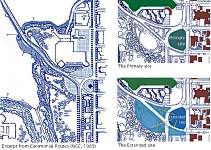
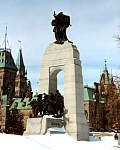
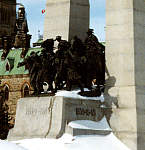
figure A figure 1 figure 2(a) figure 2(b) National War Memorial and the Politics of Location Standing on a crest at the junction of three main streets in central Ottawa, the National War memorial was created out of an international competition estcablished in 1925. A winning design chosen from 127 entries was selected in 1926. The design of Vernon March, a 31 years old English Sculptor, was ti include 19 (later 22) figures dressed in the uniforms of the various branches of the Canadian forces, 2 horses and an eighteen-pound field gun, all cast in bronze, moving in a column through a granite arch surmounted by two cast-bronze allegorical figures (Figure 2). Following 'a host of problems', including protracte difficulties in procuring the site, the entire memorial scheme was not concluded until 1938 (38). It was unveiled in May 1939, just months before the outbreak of another war.
Central to the problem of location had been the role of Canadian Prime Minister, Mackenzie King. who cherished ambitions of reshaping the capital. By siting the memorial in Connaught Square (refashioned in 1927 as Confederation Square) he argued that a neutral space could be transformed into a politicised plaza worthy of Canada's emergent national identity. Many argued that the memorial should be placed in more sedate surroundings, while others believed it should it should be closer to the parliament buldings, on 'national property (43)'. Its final position makes it a monumental 'hinge' in the urban scheme of early twentieth century Ottawa. It plays a crucial topographic function as a terminator for the formal axis of Elgin Street and as a meeting point for several districts of the capital. Furthermore, it has a distinctive silhouette, derived from its construction as triumphal arch, cenotaph and enlarged sculptural plinth, which is crucial to the spatial dynamics of the capital and renders it instantly memorable. 'Without it, Confederation Square' or 'confusion square' as it was once described 'would simply be a rather formless and dispersed traffic intersection (44)'. Furthermore, as Boisvert (45) suggests, the silhouette affords the memorial a distinctive and memorable motif which reproduces well in photographs, often the only means by which many distant Canadians might see their National War Memorial. In his report on Ottawa's urban centre commissioned by the National Capital Commission in 1988, Roger du Toit (architect and professional advisor to the scheme) drew lessons from the bold siting of March's memorial. He examined the other principal markers and nodal points of the city, identifying their importance as structural devices which linked nationally significant institutions and places (46) while leding emphasis, distinction and a visual coherence to the streets (47). Historically, he argued, principal markers - obelisks, fountains, arches - helped punctuate a sequence of streets, or terminated long vistas, and were regarded as crucial landmarks in the reshaping of parts of a capital city. In the revisions to central Ottawa in the 1980's, any proposals for the Peacekeeping Monument would also have to maximise these topographical criteria. In many ways, the brief for the Peacekeeping Monument was a re-run of the debate of the 1920's. In 1988 there were similar aspirations for the key civic routes and loci of the capital. In 1983, a National Capital Commission paper on Ceremonial Routes had identified the importance of a Ceremonial Ring, to be known subsequently as Confederation Boulevard, which would link Ottawa with nearby Hull. As one of the most important nodes in that ring, the site of the Peacekeeping Monument was regarded as the critical urban room in the development scheme. Like march's Great War memorial, the monument was intended to be a symbolic pivot in the elaboration of Ottawa. To those conversant in the field of civic commemoration there is much that is familiar in these ambitions to revitalise and manipulate public space through the siting of monumental artworks. In the 'monumental era' after the First World War the positioning of civic memorials was often regarded as integral to the reconfiguration of city space, especially to the reordering of a new civic or state order. As the work of Matsuda (48) has shown, rivalries for the mnemonic spaces of cities have often been fierce and dramatic. In most cases it is possible to identify the rival groups who argued over territorial and symbolic dominance; invariably they consisted of ex-service organisations, the bereaved, the principle fundraisers and private donors, town planners and urban developers. Many are the examples of prolonged disputes where ex-servicemen felt that they were being manipulated by municipal authorities who appeared more intent on promoting a memorial scheme as part of a comprehensive urban planning development than representing the proper memory of their dead comrades. The management of choice, argues King, is often complex, convoluted and 'thoroughly ambiguous'.(49) It may seem odd that the siting of a monument should arouse such anxieties, perplexing that icons of national reverence and remembrance such as the National War Memorial should have once seemed so complex and elusive. But this is to ignore the debates about the way in which memorials encapsulate and perpetuate memory. As Johnson tells us, such sites of memory are rarely arbitrary assignations: instead they are 'consciously situated to connect or compete with existing nodes of collective remembering(50)'. Containing and conveying memory, monuments to war exist not only as aesthetic devices but as apparatus of social memory,(51) a phenomenon Boyer describes as 'rhetorical topoi':
In the perceptions of many pacifists, the concept of a 'Peacekeeping Monument' is an oxymoron: how can one commemorate peace as if it were a defined segment of historic time? Furthermore, how can the ideals of peace be expressed figuratively, or as part of an urban scheme that specifies intelligibility as the leading aesthetic criterion? This is especially pertinent when one compares Barbara Hepworth's non-figurative sculpture placed in the forecourt of the UN building in NewYork with the rigid aesthetic criteria for the Ottawa scheme. If the 'Peacekeeping Monument' is intended as a monument to the pacilVing role of unarmed soldiers, how could the invited design teams devise an architectural format and a figurative form that would project the idea of consent, impartiality and 'conflict control' while mindful of the precedent set by March's sculpture some hundreds of metres away? We should explore the winning design in some detail. The Reconciliation as Icon of Peace The Reconciliation was designed by sculptor Jack K. Harman, architect and urban designer Richard G. Henriquez, and Cornelia Hahn Oberlander, landscape architect. (56) Their design has a number of elements: a corridor of concrete and steel debris inside two solid granite walls upon which are mounted a trio of bronze cast figures (Figure 3). Set to one side of the monument is a grove of twelve oak trees arranged around an ovoid mound, adjacent to which is a semi-circular ceremonial space. As a motif, The Reconciliation makes a simple theatrical statement that is spelt out on a plaque:
Although the grove of trees is integral to the monument, it is easy to overlook (Figure 6). Consisting of twelve trees (oak was selected for its longevity) the number is meant to represent the ten provinces and two territories of Canada. Like March's sculpture with its panoply of characters drawn from all parts of the country, the grove is an attempt to recognise the national spectrum from which Canadian peacekeeping forces are drawn. As a symbolic motif the grove draws weakly from the rich memorial tradition of the heroes' grove that became a staple icon in 19th-century Germanic landscapes of remembrance. (57) As public art, the monument has two very different profiles. Approached from the north via the Hull-Ottawa road, the three figures and the reflective surface of the apex dominate the urban room; from the south, the primary sensation is of two distinctive spaces-an enclosed corridor and a ceremonial open area. Despite the sense of enclosure there is, however, little relief from the noise of passing traffic. As an emblem the monument is rather overwhelmed by the adjacent post-modern architecture, the glass tower of the National Gallery to the north and the unwelcoming glazed exterior of the US Embassy some 50 m to the south. So surrounded by rather eccentric new buildings (which are also heavily laden with ideological meaning) the monument fails to dominate the urban room for which it was intended. Aesthetically, there is a strained relationship between Harman's cast figures and the angularity of the monument; the tonal contrast between the 3 m high dark statues and the expanse of smooth pale stone is too extreme (Figure 7). Unlike March's memorial, the figures do not relate well to the larger architectural whole. In March's sculpted group the arrangement of form has been calculated so that light falls at intervals across the figures, lending momentum to their forward movement through the arch. By comparison, the figures in Reconcilation, though bold in silhouette, do not seem to function as an aesthetic unit, nor relate in their proportions to the greater architectural whole. Compromised by the need for 'figurative intelligibility' the effect is one of discordant elements separately assembled. Further evidence of this lack of a unifying sensibility is the 'peace grove', which remains a visual afterthought appended to fill, rather than create, space. As a sequence of visual ideas, the monument suffers from narrative confusion. How, for example, are we meant to 'read' the smooth outer walls of the monument? They act as a formal counterpoint to the 'ruins' of the corridor space, but do they represent the forces of impartiality, reason and arbitration, or are the walls merely an architectural plinth for the lead signifiers, the three unarmed figures? 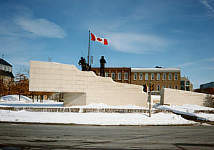
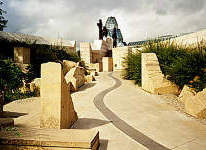
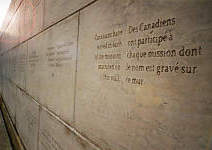
figure 3 figure 4 figure5 As a monument, Reconciliation cannot, of course, be appraised in isolation. As befits a nation with a significant peace movement, the civic landscape of Canada is peppered with gardens, parks, bridges and other public spaces dedicated to peace, many of them symbolically sited along the US/Canada border. In 1994 the Canada 125 Project, in partnership with the National Capital Commission, attempted to consolidate, and in effect co-opt the movement by dedicating 400 peace parks across the country. Many of these were extant open spaces created by pacifist and anti-war groups that were re-inscribed for the purpose. Others were designed with a 'Peace Grove' consisting of twelve trees as a symbolic link to one another and as a reference to the monument in Ottawa. Significantly, the parks were simultaneously dedicated on 8 October 1992 as Reconciliation was unveiled in Ottawa. By this gesture, the state laid its imprint and controlling measure on the rhetoric of peace. In so doing, the monument's function as a symbol of peace (not merely peace keeping) was extended across the country. In this way the monument was freighted with a complex amalgam of themes-world peace, disarmament, reconciliation, intervention, arbitration, unarmed heroism-few of which it was ever intended to serve. By such inclusive action, the 125 Project-intended to celebrate a major anniversary in Canada's history-firmly located Reconciliation as a precursor of future peace spaces and as the symbolic emanation of the idea of peace. 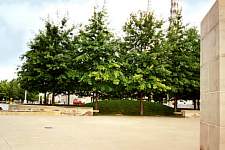
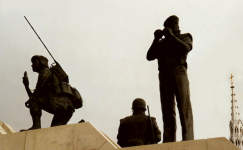 figure 6 figure 7 Despite these associations Reconciliation neither satisfies as a polemic against war, nor as a declaration of peace. As monumental sculpture, it is neither metonymic, nor interrogative; it does not evoke shared memory nor does it pose many awkward questions. Unlike most 'war' memorials it makes no attempt at closure or the resolution of private or public suffering. It does, however, record the historic involvement of Canadian troops. And, with sufficient space for thirty future campaigns, it presupposes a future peacekeeping role for Canadian troops into the next two decades. In this sense it projects a future role with some certainty, suggesting that the Canadian values of impartiality and fairness will be constants worthy of continuous aggrandisement. However, because of global events that took place as the monument was under construction, Reconciliation was transformed from a form that idealised passive intervention and arbitration to one that merely recorded an historic role as UN peacekeeping. Canada's unfortunate involvement in the Somali Civil War confirmed its fallen status as an arbiter. Despite its constant evocation as a symbol of peaceful intervention and its regular use as a dignified and ceremonial space, Reconciliation is little more than a memorandum in stone to a distinctive phase of Canadian military history. In this capacity, however, the monument appears to have gathered some status amongst former Canadian soldiers. It acts as a physical (and virtual) focal point-much like a regimental reunion or garrison town-for a community of ex-servicemen who once served as UN peacekeeping. For many in this community, the monument acts as a bold visual logo that regularly adorns Internet sites dedicated to the topic. In this way it replicates the visual impact of the striking silhouette of March's memorial. However, a portion of former Canadian soldiers who have served in peacekeeping roles have recently raised objections to the factual and symbolic purpose of the monument, suggesting that the list of missions carved on its northern face are 'gross inaccuracies' which render the monument a 'National embarrassment'. (58) But more pointedly, the veterans argue that the monument serves no memorial function. Although it honours a national ideal and an international principle, it does not remember those who died on peacekeeping service. In their vociferous campaign, veterans draw on the heightened rhetorical language of the Great War-using phrases such as 'the fallen' and 'ultimate sacrifice'-to articulate their grievance. The campaign marks the point where monumental form is re-invigorated and re-inscribed as a point of collective remembrance, and also where an emblem of peace is transformed into a memorial to those who died in martial conflict. The value of Reconciliation as a contemporary icon of national esteem was perhaps further undermined by the decision in 2000 to locate Canada's 'soldat inconnu' besides March's National War Memorial in Confederation Square. Such action is part of a continuing intensification of the National memorial site and appears to further erode the impact of The Reconciliation. Conclusion The first part of this paper examined the iconography of peace and its articulation in the funerary statuary of the period after the First World War in Britain and parts of the empire. By examining the semiotic and iconographic differences between a 'monument to war' and a 'memorial', the paper has teased out some of the subtle distinctions between the two forms and has suggested some new readings of familiar civic memorial sites. Lacking a suitable rhetoric, it has been argued that the language of peace is often best expressed by temporary artistic intervention rather than a fixed monumental artefact. Through focusing on the first ever monument to peacekeeping, it has been suggested that the Reconciliation monument was predicated on a number of expectations. Firstly, that it would replicate the spatial and symbolic impact of the National War Memorial, secondly it would revitalise and embellish a new civic and political space, thirdly it would form the monumental centrepiece of Canada's foreign policy. Furthermore, although the monument was designed to promote the virtues of unarmed intervention, arbitration and reconciliation it came to be identified as a pivotal element in a network of public spaces dedicated to peace and pacifism. In this way the monument assumed multiple symbolic functions which were largely fabricated, and were later reneged upon by Canada's involvement in global conflict and in messy policing actions. As a monument to a particular phase of Canadian military history, Reconciliation serves as a useful, if slightly ungainly, visual footnote to Canadian foreign policy aspirations. As public art, it has little new to add: it develops some of the spatial and dramaturgical themes that are typical of contemporary Canadian monuments, but its aesthetic ambition is compromised by a disunified treatment and unreasonable expectations of its impact as a processional space. In this last respect, however, the frequent use of the ritual space suggests that the monument is valued by ex-servicemen as a bold emblem that notes their part in resolving global conflict, but one that fails to commemorate lives lost in the pursuit of that ideal. Acknowledgements Fieldwork for this paper was made possible by a Canadian Studies Faculty Research Programme Grant awarded by the UK Canadian High Commission. In 1999 the UK British Council also sponsored a lecture tour and visit to Canada. I would like to thank Laura Brandon and Dr Cameron Pulsifer at the Canadian War Museum, Ottawa, and Professor Brian Osborne, Queen's University. I am grateful for advice from two anonymous referees who advised on earlier drafts of this paper. Bibliography: 1 See, for example, J.M. Mayo, War memorials as political landscape: the American experience and beyond, New York: Praeger, 1988; S. Hynes, A war imagined: the First World War and English culture, London: Bodley Head, 1990; G. L. Mosse, Fallen soldiers: reshaping the memory of the IThrld Wars, New York and London, 1990; A. Borg, War memorials, London: Leo Cooper, 1991; J. Winter, Sites of memory, sites of mourning, Cambridge: Cambridge University Press, 1995. 2 A. Danto, 'The Vietnam Veterans Memorial', The Nation, 31 August 1986, p152. 3 A. Riegi, Der Moderne Denkmalkultus (1903) in Gessameire Aufsatz, Filser, Augsburg, 1928, pp144-193, cited in R. Burstow, Materialising memory: mementoes, memorials and modernism, pp.8-12, catalogue essay for In Memoriam, Walsall Art Gallery, 22 November 2000-21 January 2001. 4 M. Rowlands, 'Remembering to forget: sublimation as sacrifice in war memorials', in A. Forty and S. Kuchler (eds) The art of forgetting, Oxford: Berg, 1999. 5 M. Cousins, 'Inside, outside', Tate Magazine,Winter 1996, pp.36-41. 6 J. Winter, BBC History, November 2000, pp.22-25. 7 K.S. Inglis, 'The homecoming: the war memorial movement in Cambridge, England', Journal of Contemporary Histo ry, Vol. 27, 1992, pp583-605. 8 A. King, Memorials of the Great War in Britain: the symbolism and politics of remembrance, Oxford: Berg, 1998, p68. 9 N. Hewitt, 'The national inventory of war memorials: profile of a national recording project', in J.M. Teutonico & J. Fidler (eds) Monuments and the millennium, London: James & James, 2001, pp13-23. 10 Rowlands, op. cit. (note 4), p.131. 11N. Johnson, 'Cast in stone: monuments, geography and nationalism', Environment and Planning D:Society and Space,Vol. 13, 1995, pp.51-65. 12 J. Winter, op. cit. (note 6). 13 D. Lowenthal, The past is a foreign country, Cambridge: Cambridge University Press, 1985, p.232 14 Hynes, op. cit. (note 1). 15 S. Michalski, Public monuments: art in political bondage, 1870-1997, London: Reaktion, 1998. 16 I am indebted to Professor Sally Morgan for a number of the thoughts expressed in this section. 17 illustrated in D. Boorman, At the going down of the sun: British First World War memorials, York: Derek Boorman, 1988. 18 A. Jones, Memoirs of a soldier-artist, London: Stanley Paul, 1933, p181 19 Ibid., p.181 20 Poetry of the Great War-an anthology, London, Penguin, 1999. 21 A. King, op. cit. (note 8), pp179-180 22 Keighley News, 6 December 1924, cited in King, op. cit., p179 23 A. Jones, op. cit. (note 18), p185 24 G. Dyer, The missing of the Somme, London: Penguin, 1994, p.51 25 See P. Brock & N. Young, Pacifism in the twentieth century, Syracuse: Syracuse University Press, 1999; and P. Brock, Studies in peace history, York: William Sessions, 1991. 26 P. Gough, 'From heroes' groves to parks of peace', Landscape Research, Vol. 25, No. 2, 2000, pp213-229 27 5. Michalski, op. cit. (note 15), p.202 28 For a full bibliography see P. Gough, op. cit. (note 26). 29 J. Leonard, Memorials to the casualties of conflict, Northern Ireland 1969 to 1997. A report commissioned by the Northern Ireland Community Relations Council and the Arts Council of Northern Ireland, Belfast: Northern Ireland Community Relations Council, November 1997. 30 Ibid., p. 28. The artist was an art student from the University of Ulster, Hilary Gihigan. 31 www.iol.iw/-mcmuhhinlcairn.html, last accessed in September 2001. 32 Competition guidelines published by the National Capital Commission and National Defence, 1990, p1 33 J. Coulon, Soldiers of d:II,iomacy: the United Nations, peacekeeping, and the new world order, Toronto: University of Toronto Press, 1998, p.165. 34 J.T. Jockel, 1994, in Coulon, ibid., p. 166. 35 For an analysis of peacekeeping in Africa see B.D. Jones, Peacemaking in Rwan&s: the dynamics of failure, New York: Lynne Rienner, 2001. 36 N. Hiimer & J.L. Granatstein, Empire to umpire: Canada and the world to the 1990s, Toronto: Copp Clark Longman, 1994, p.321. 37 The eight principles required the monument to 'include symbols which were easily recognizeable by a broad spectrum of the population', to 'include the literal images and words necessary to explain the activities commemorated', to be 'an effective formal venue', to 'encourage and facilitate casual social interaction', 'contribute to the visual coherence and livability of the urban environment', 'display artistic, design and technical excellence', work within 'established construction schedules' and, finally 'the design should ensure the longevity of the Monument'. Taken from Competition guidelines, 1990. 38 This is examined in J.F. Vance, 'The great response', The Beaver, October-November 1996, pp.28-32. 39 Thid., p.28. 40 T. Wayling, Madean's Magazine, Ottawa, 15 December 1938, p.23. 41 Quoted in Jim Garner, Ottawa Citizen, 27 May 1978. 42 J.F. Vance, op. cit. (note 38), p. 28; J. Tucker, 'Lest we forget: national memorials to Canada's First World War dead', Journal for the Study of Architecture in Canada, Vol. 23, No. 3, 1998, pp.88-95. 43 J.F. Vance, Death so noble: memory, meaning and the First World War, Vancouver: UBC Press, Canada, 1997. 44 R du Toit 1988, cited in Competition guidelines, p13. 45 C. Boisvert, 'Images of blood carved in stone: the National War Memorial's role in defining a nation', unpublished MA dissertation, Carleton University, 1996. I am indebted to Laura Brandon, curator of war art at the Canadian War Museum, Ottawa, for some of the ideas developed in this section. 46. R. du Toit, An urban design study for memorials in the core of the nanonal capital, Ottawa: National Capital Commission, 1988, p. 3. 47 duToit, ibid., pp.24-25. 48 M.K. Matsuda, The memory of the modern, Oxford: Oxford University Press, 1996. 49 A. King, op. cit. (note 8), p.2. 50 N. Johnson, op. cit. (note 11), p.55. 51 S. Morgan, 'Memory and the merchants: commemoration and civic identity', International Journal ofHeritageStudses,Vol.4, 1998, p103. 52 M. Christine Boyer, The city of collective memory, Cambridge, MA: MiT Press, 1996, p32. 53 B. Osborne & G. Osborne, 'The Cast(e)ing of heroic landscapes: constructing Canada's Pantheon on Parliament Hill', in R. Blake & A. Nurse (eds) The politics of nationality: essays on Canadian nationalism, citizenship and national identity. Totonto: Harcourt-Brace, 2002. 54 K. Verdery, The political life of dead bodies: reburial and post-social change, New York: Columbia University Press, 1999. 55 B. Osborne, 'Warscapes, landscapes, inscapes: France, war and Canadian national identity', in I. Black & R. Butiin (eds) Piace, culture and identity, Laval: Laval University Press, 2001. 56 The full design team consisted of Jack Harman: sculptor, Gibson's, BC; Richard Henriquez: urban designer, Vancouver, BC; Cornelia Oberlander Hahn: landscape architect, Vancouver, BC; Gabriel Design: lighting, Ottawa, Ontario; J.L. Richards: engineering, Ottawa, Ontario. 57 See, for example, www/rockiesnesl-spirit.com the homepage for the Canadian Peacekeeping Veterans Association which contains their authoritative list of UN missions. Further views on the demerits of the monument are carried on http://perc.ca/PEN/ 58 Phrase used by veteran in website www.islandnet.coml-duke/monument.htm accessed September 2002. top back |